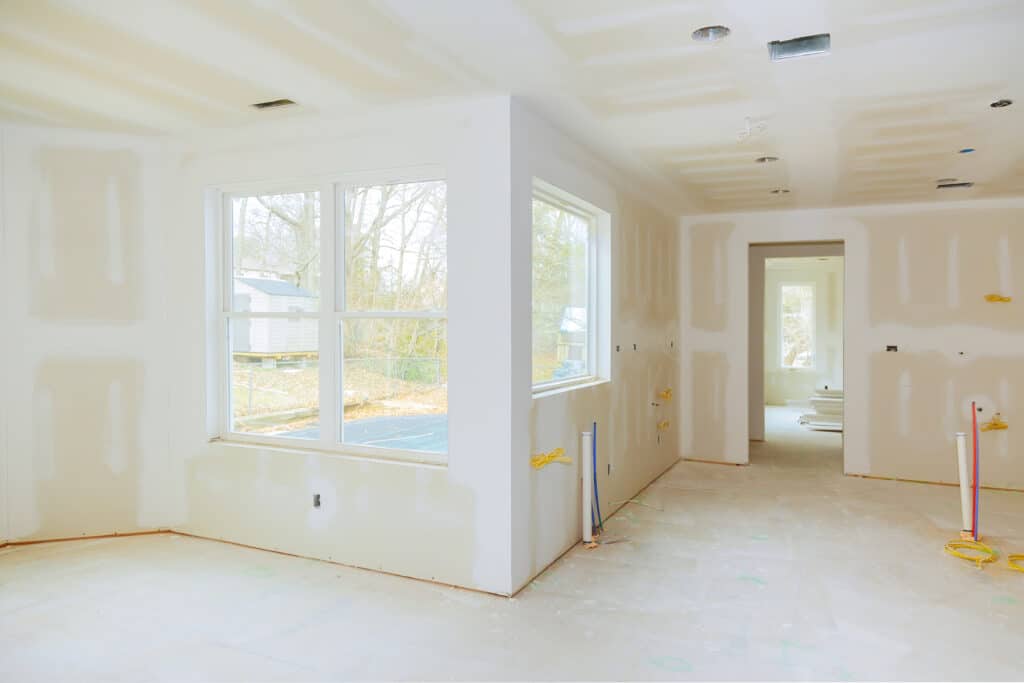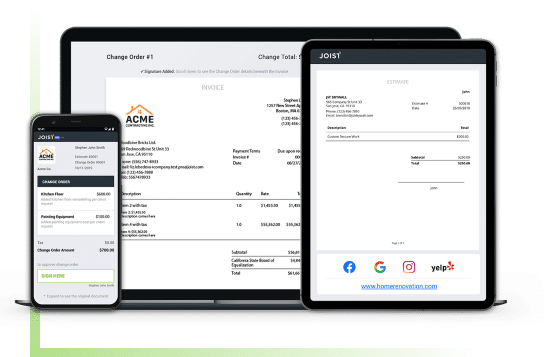Landscaping Pricing Guide: How to Price Landscaping Jobs
As a drywall contractor, do you struggle to set the right pricing to make sure every job is profitable? If so, you’re not alone. Understanding what to factor in for pricing is one of the biggest obstacles to a profitable drywall business.
There are many variables to consider when setting prices, including billable and unbillable hours, overhead, and labor rates, to name just a few. There are also the rates charged by your local competition to consider.
This drywall pricing guide will walk through the steps to price a drywall job correctly and how to create estimates that will win you more bids.
Flat-Rate vs Hourly Rates for Drywall Jobs
Generally, you’ll offer one of two pricing models for a drywall job. The hourly rate model and the flat-rate pricing model.
Depending on what’s best for your drywall business, you may decide to use one over the other or a combination of the two.
Hourly Pricing (Time + Materials)
In the hourly pricing (or per hour) model, customers are billed by the hour at a rate that covers time and materials. The total cost of the drywall job is determined mainly by how long it takes to complete.
Hourly pricing appeals to some customers because of the perceived transparency in the charges. The itemized estimate shows the customer the hourly pricing and material costs.
However, this pricing model can cause certain customers to “clock watch.” Dissatisfied customers may even excuse you of intentionally working slower to run up the bill. Further, any hourly-priced job will include a certain number of unbillable hours. Mainly from the time spent creating estimates and invoices.
Flat-Rate Pricing
Unlike hourly pricing, the customer pays a flat rate for the entire job, regardless of how many hours it takes to complete. This flat rate is calculated by factoring together all required labor costs, materials, and overhead.
This model allows you to offer a menu of add-ons and upgraded drywall services that customers can include with the original job. It also limits the number of unbillable hours you work because you won’t need to create a new estimate and invoice for each drywall project.
Using a flat rate also gives customers increased pricing transparency. They will know from the beginning what their final invoice amount will be. This prevents sticker shock after the job is finished. Plus, you’ll know exactly how much money you’ll earn on the project.
Hybrid Pricing
Using a combination of hourly & flat-rate pricing might be the right approach for your drywall business.
For example, some drywall contractors use an hourly rate model on large, complex jobs. Then, they’ll offer flat fate prices on smaller, more straightforward jobs.
Using a hybrid model gives you pricing flexibility. You can choose the model that makes the most sense for the individual job. This should increase customer satisfaction and simplify your pricing process.
No matter the pricing model you choose, investing in drywall estimating and invoicing software can help improve accuracy when you price drywall jobs.
The right software tool will streamline your estimate creation by logging your popular services and storing material, labor costs, and overhead pricing. And after the job, you can send easy-to-pay professional invoices in just a few clicks to your customers.

How to Calculate Drywall Costs
The first step to pricing a drywall job is to ensure you understand all the costs and expenses included in the job.
This includes drywall, mud, screws, tape, and other supplies. Labor costs should also be included when estimating how much it will cost for the job.
Any additional services or products needed for the job may add to the overall cost. Additionally, make sure to factor in transportation costs and any fees associated with permits or inspections.
Once you have established how much it will cost for the entire project, you can then calculate how much you should charge your client. To do this, consider the following:
- How long will the job take to complete?
- How much experience and expertise are needed for completion?
- How competitive is the market in your area?
The goal is to find the right balance between competitive pricing and still making a profit from each job.
How Do You Calculate Drywall Material Costs?
To calculate your material costs, start with an itemized list of the materials and supplies necessary to do the job. Use the following formula to calculate the cost of materials:
Total of required materials x Sales Tax at Counter = Total Materials Cost
If the materials to replace the drywall in one room add up to $286.98 and sales tax in your area is 6%, for instance, your total material cost for the job is $304.19.
When pricing drywall jobs, be sure to consider all potential costs. Forgetting to account for expenses will cut your profit margin and potentially embarrass you in front of the customer.
Here are some possible costs and expenses to include in your drywall estimate:
- Removing old drywall
- Debris removal from the job site
- Correcting any violations of existing building code
- Providing drywall materials like screws, mud, tarping, and tape
- Any required permits
How Do You Calculate Labor Costs for Drywall?
Determining your hourly base rate is the first step in calculating drywall labor costs. That’s the amount you pay your employees or yourself before adding material and overhead costs.
You should factor in each worker’s experience when determining the base rate. For instance, more experienced drywallers may warrant a higher hourly rate than less experienced ones. Additionally, you’ll want to include any additional fees, such as travel time or overtime, in the calculation.
To estimate your labor costs, take the amount of money you’d like to earn every week and divide it by the number of billable hours you work.
Weekly Income ÷ # of Billable Hours per Week = Hourly Base Rate
For example, you want to make $900 in a 40-hour work week. Out of those 40 hours, only about 55% will be billable. The other 45% is spent on unbillable things like driving to jobs and administrative tasks. That leaves you with 22 hours of billable time.
We’ll divide your $900 weekly income by the 22 billable hours and get an hourly base rate of $40.91, which we’ll round up to $41.
How Do You Calculate Drywall Overhead?
Drywall overhead is the cost of materials, labor, and any other expenses related to the project.
To calculate how much drywall overhead you’ll need for your project, determine how much material will be required. The size of the job largely dictates this. Is it a single room or an entire building?
The quality of the material also impacts your overhead. Is the customer requesting the cheapest material to save on cost? Does the building code require you to use more expensive fire-resistant materials?
Next, add up how much it will cost to install the materials. This typically includes costs such as labor, tools, and any additional supplies.
Finally, factor in how much time it will take to complete the project so you can estimate how much it may cost for that labor.
When all these factors are considered, you should know how much it will cost to complete the drywall project.
Overhead costs include:
- Business equipment such as computers, printers, or cell phones
- Rent and utilities
- Employee salaries
- Permits and licenses
- Safety equipment
- Drywall tools such as ladders, nail guns, smoothing knives, hammers, etc.
- Vehicles, fuel, and maintenance
- Taxes and business insurance
- Drywall advertising and marketing
- Drywall business management software
- Credit card processing fees
- Employee benefits
Calculate your hourly overhead costs by dividing your yearly overhead costs by the number of billable hours per year. We use a whole year to calculate overhead to address seasonality.
Total Yearly Overhead Costs ÷ # of Billable Hours per Year (Total Number of Employees x Hours They Work Over the Week x 52 Weeks) = Hourly Overhead Costs
For example, if your business’s total yearly overhead costs are $42,000 and we divide it by your team’s 4800 billable hours a year, your hourly overhead costs are $8.75.
Once you’ve determined your hourly overhead cost, you’ll use that to determine your overhead expenses per job. To calculate the overhead costs for an individual drywall job, use the formula below:
Hourly Overhead Costs x # the Hours to Complete the Job = Overhead Cost for the Job
Going back to our earlier example, if removing the old drywall will take an hour and a half to complete, we’d multiply $8.75 by 1.5 for a total overhead cost of $13.13.
Need a way to sync your estimating and payment processes?

How to Determine Competitive Rates/Pricing
Pop quiz: What’s more important, competitive pricing or profitability? We agree. It’s both. That’s the struggle in business. There’s a fine line between staying competitive and racing your competition to the bottom of the bargain basement.
Here are a few things to consider when finding the right balance between competitive pricing and profitability.
Doing Competitive Research
You can use the rates and prices of the competition to measure how reasonable your prices are compared to the businesses you compete against. However, it might be better to use the competition to assess your cost of operation. You should reevaluate and adjust your rates if you are way above or below your competitors.
That’s not to say you must match your competition’s rates exactly. Their costs, overhead, and goals will undoubtedly be different from yours. If you try to fit your prices to the competition rather than your unique process, charges, and objectives, you will certainly cut into your profits and affect your bottom line.
Remember that you can set yourself apart with more than just lower prices. Many people are willing to pay for top-notch customer service and efficient, quality work.
What is the Ideal Profit Margin for Drywall Companies?
Your profit margin is the money you’ve made after you’ve paid your employees and covered materials costs and overhead.
As specialty contractors, drywallers should aim for at least a 15-to-20% profit margin. Your ideal profit margin will depend on your costs and financial goals.
How to Calculate Drywall Profit Margin
To calculate your existing profit margin, start by calculating your net profits by using this formula:
Total Revenue – Material Costs – Labor Costs – Overhead Costs = Net Income
Once you have your net income, you can determine your profit margin using this formula:
Net Income / Total Revenue = Profit Margin
To include your profit margin on the cost of materials for a particular job, use the formula below:
Total Project Material Costs + (Total Project Material Costs x Profit Margin) = Total Project Material Costs
You can begin to set ambitious, achievable goals based on your current profit margin. You may need to determine which profit margin will best help your drywall business reach its financial goals.
How to Calculate Drywall Markup
Markup is key when it comes to pricing your drywalling services. How much you decide to mark up the cost of ad hoc materials and other expenses will determine your business’s profitability.
Markup refers to the difference between your cost and the price charged to the customer. Adding a markup to the cost of materials accounts for both overhead and profit. Calculate your markup percentage by using this formula:
(Selling price – Your cost)/Your cost x 100 = Markup percentage
For instance, if you pay $10 for drywall materials and charge your customer $15, you have a markup of 50% on your materials.

How to Create a Professional Drywall Estimate
Creating a professional drywall estimate can seem like an intimidating task. However, with the right approach, it doesn’t have to be.
Before starting, it is important to understand what goes into making an accurate and professional estimate. Here are some tips and tricks to help you get started:
- Measurements – Take precise measurements of the area you need to work on before giving a quote. Knowing the exact dimensions will give your customer confidence in your accuracy and attention to detail.
- Material Choices – Explain different types of materials available for their project, so customers have a better understanding of what’s best for their budget and needs.
- Labor Costs – Calculate labor and subcontracting costs
Knowing how to estimate drywall jobs accurately will make the difference between making a profit and taking a loss.
After establishing how you are pricing jobs, you’ll still need to determine how much to charge for each project. To create an estimate, follow these steps:
- Total the cost of materials, including parts and disposal
- Determine total labor costs
- Calculate the total cost of the project
- Factor in overhead
- Incorporate profit margin
- Compare the total to the drywall pricing guide to stay reasonable
Once you’ve determined your price for the job, you want to create a professional estimate.
Presenting a potential customer with a professional-looking, branded document is the first step to establishing yourself as an expert and winning the bid. Your estimate should include the following elements:
- Business name and logo
- Business contact information
- Client name and contact information
- A quote/estimate number
- A detailed breakdown of the service you’ll be providing, materials, and costs
- The total cost for the service, including taxes
- The date that the estimate expires
In the drywall business, time is money. And time spent creating estimates and invoices is unbillable time. Joist, an estimating and invoicing app, allows trade contractors to develop and deliver accurate estimates in just minutes.
Our easy-to-use mobile estimating tool will add more billable hours to your week. Joist lets you build custom estimates, invoices, work orders, and more from any web-connected device.
Need to estimate a drywall job?
Joist can help.